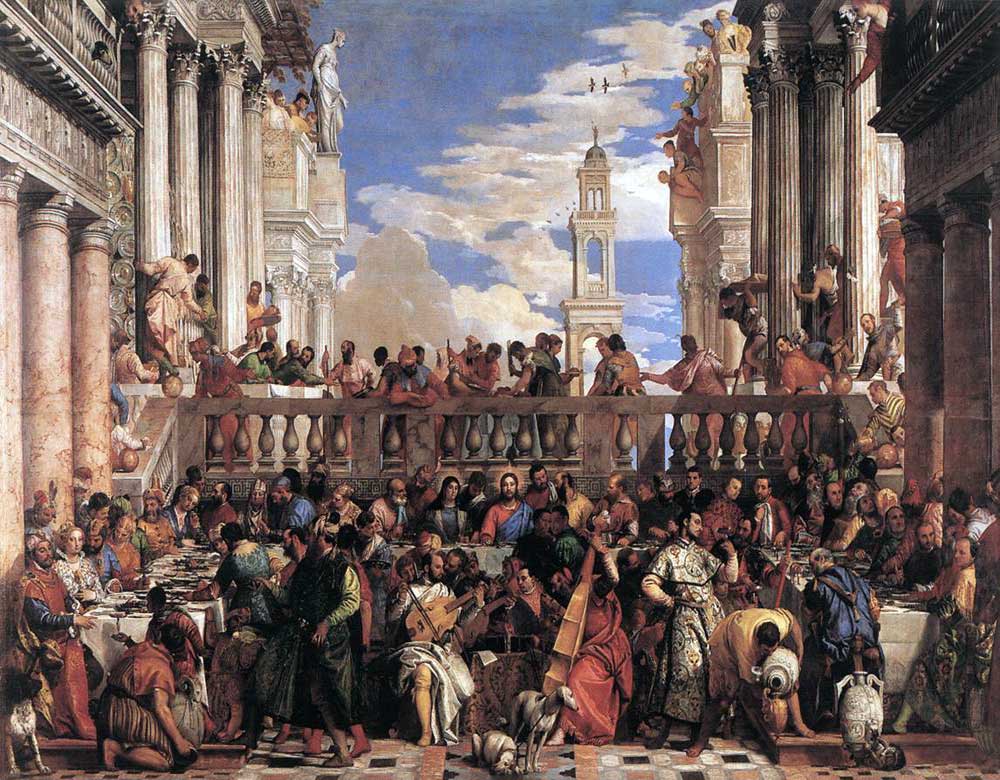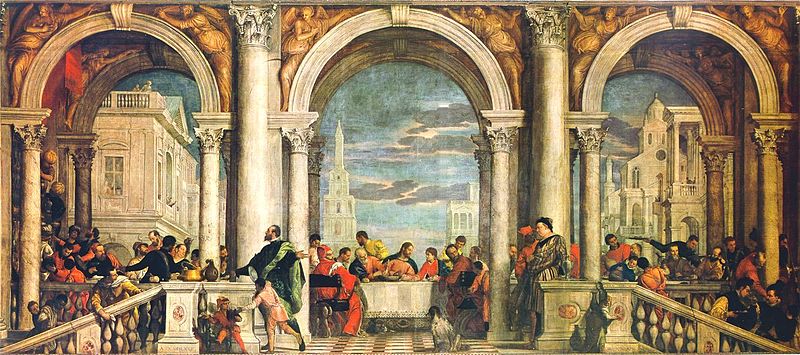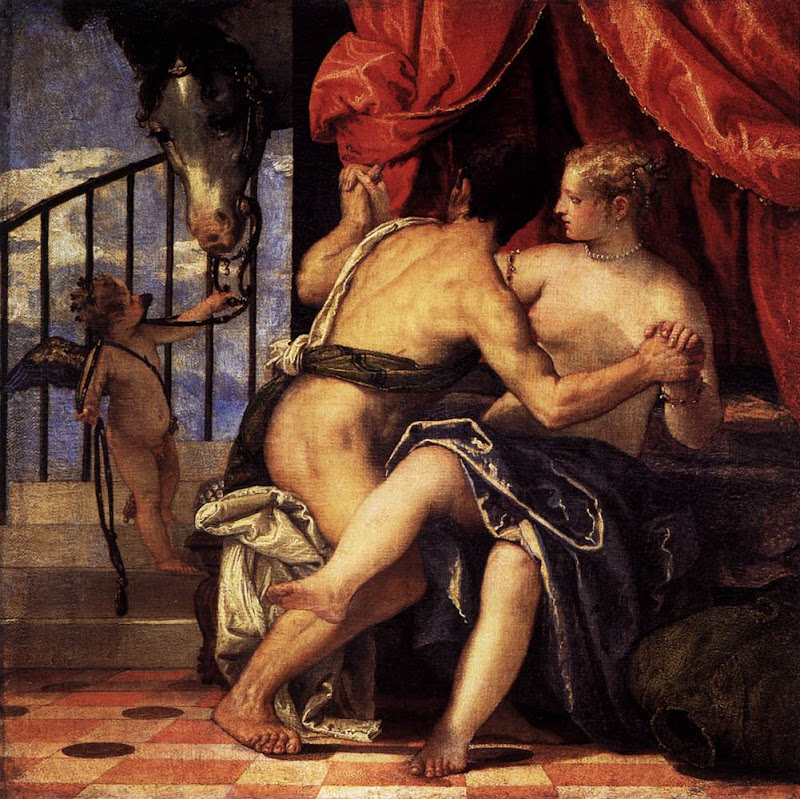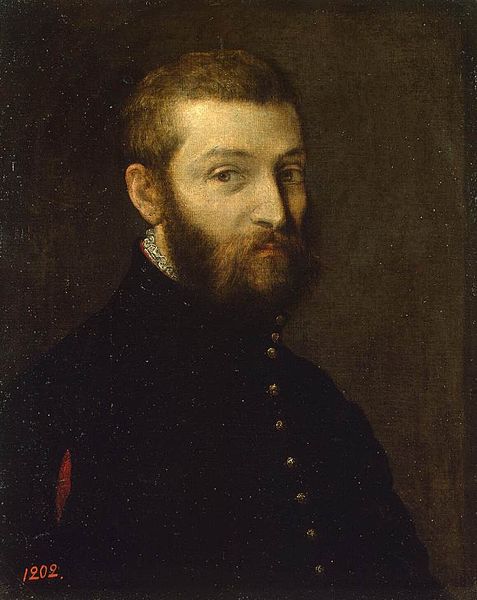
《迦纳的婚礼》,藏于 卢浮宫

《利未家的宴会》

Venus and Mars with Cupid and a Horse
Portrait of a Man by Paolo Veronese Museum of Fine Arts, Budapest
Lucretia by Paolo Veronese 1550, Kunsthistorisches Museum, Vienna

《降服亚历山大大帝的波斯王达利乌斯全家The Family of Darius before Alexander 》
National Gallery, London
St John the Baptist Preaching Galleria Borghese, Rome
The extraordinary beauty of the Venetian fabrics already to be found in the work of Palma il Vecchio is brought to unrivalled perfection by Paolo Veronese. In the St John the Baptist Preaching (c. 1562), which heralds the coming of Christ, the figures are wrapped in magnificent oriental silk robes and three are wearing turbans. Their differing reactions to the sermon are reflected in their facial expressions. The skilful composition of the painting creates a balance between the weight of the group of figures on the right and the perspective on the left.
Mars and Venus United by Love by Paolo Veronese
Metropolitan Museum of Art, New York
This is one of the greatest works by Veronese, whose brilliant use of colour and sensuous female figures influenced European artists from the time of Rubens to that of Delacroix. Together with four other allegorical paintings by Veronese, the picture was owned by Emperor Rudolf II in Prague. Although generally thought to show the goddess of love united by Cupid to the god of war, the picture has also been interpreted as showing Chastity transformed by Love into Charity; the horse restrained by an armed Cupid may symbolize restrained passion.

Susanna in the Bath
There was a considerable contribution of the assistants, including Veronese’s brother, Benedetto Caliari, to the execution of this painting.

Portrait of Agostino Barbarigo by Paolo Veronese
Oil on canvas, 60 x 48 cm
Museum of Fine Arts, Budapest
Agostino Barbarigo, the famous commander of Venice, fell in the battle against the Turks at Lepanto in 1571. There is a larger painting in the Cleveland Museum showing Barbarigo in a similar representation. It is believed now that the picture in Budapest is a study to the larger painting in Cleveland.

detail from wedding at Cana
Susanna in the Bath

Museum of Fine Arts, Budapest
information from:
http://blog.allartpainting.com/tag/paolo-veronese-painting/
http://www.lib-art.com/artgallery/554-paolo-veronese.html

保罗·委罗内塞(1528年-1588年4月19日)是意大利文艺复兴时代的画家。
生平
委罗内塞出生于维罗纳,原名保罗·卡拉里,父亲是一名石匠,他因为出生地而获得“委罗内塞”绰号,并以此而闻名。他和提香、丁托列托组成文艺复兴晚期威尼斯画派中的“三杰”。
委罗内塞少年时师从当地一位画家,很快他就已经可以独立作画了,1544年,他已经出师,在帕尔马以风格主义画风出名,但他迅速地发展出自己颜色丰富的独特画风。
1548年,他移居曼托瓦,在为当地教堂绘制了壁画,然后定居到威尼斯,1565年,他和导师的女儿结婚,后来生了四个儿子和一个女儿。最终在威尼斯逝世。
作品
1552年,委罗内塞为圣弗朗西斯科大教堂绘制了《圣家族》,1553年,接受威尼斯共和国掌政的十人团委托,为会议厅和三巨头厅做装饰,然后又为圣塞巴斯蒂安教堂绘制了天顶画《以斯帖的历史》,为此获得公爵和圣马可图书馆授予的大师称号。但他的这些作品实际是米开朗基罗的画作中主题的精致的缩小。
从1556年到1570年,他致力于绘制《西蒙家中的宴会》,其间还受委托为新建立的巴巴罗别墅装饰,他将壁画和家族肖像融合起来,在天顶画上绘制蓝天和任务,造成三维的视觉效果。绘画和建筑效果的结合是一个非常大的成功。
1562年至1563年,为本尼迪克特教团的圣乔治修道院饭堂画的大型作品《迦纳的婚礼》,几乎有10米长,包括了一百多位人物,其中有提香、丁托列托和委罗内塞自己
1565年至1570年,他创作的《降服亚历山大大帝的波斯王达利乌斯全家》,将建筑安排和画面平行,协调不同的色块,使画面更加生动,表现了画家的装饰才能。
上述画面都是将主题安排在水平轴上,没有强烈的运动感,但表现了鲜明的光和色彩。这种表现手法反映了他本人内心舒适与安宁的心态。
1573年,他为圣乔瓦尼和圣保禄教堂绘制了《利未家的宴会》,是为了顶替被火灾焚毁的提香的作品《最后晚餐》,画作有12米长5米高,是一幅扩展了的“最后晚餐”。但画面色彩鲜明,光线充足,充分表现了人物的情感和他们之间的互动。
他这幅画原名“最后晚餐”,因此立刻招致宗教裁判所的审判,不过当时罗马天主教的改革运动已经影响到威尼斯,7月,他被要求详细说明画中的细节只是警告性的而不是惩罚性的,委罗内塞解释说:“画家有如同诗人甚至疯子一样的自由诠释能力。”最终没有要求他重新画而只是将画名改变了事。
此外他还创作过一些祭坛画,他在威尼斯有一个家庭工作室,包括他弟弟和两个儿子都在其中工作,他还有几位学生,这个画室在他逝世后仍然继续工作。
法国批评家戈蒂埃于1860年写道:“委罗内塞是最伟大的使用颜色的专家,甚至比提香、鲁本斯和伦勃朗都要伟大,因为他可以用自然的色调表现光线,现在的学院还用明暗的对比法。”
德拉克罗瓦写道:“委罗内塞不用强烈的对比表现光线,我们现在还被教育在阴影中表现强烈的色调是不可能的。”
英国皇家美术院馆长高文在《卢浮宫的绘画》一书中写道:“委罗内塞的光线充足的室外场景激发了整个19世纪,这种改革无法描述,他是现代绘画的奠基者,印象派画家认为他的方式是自然主义的,有人认为是更精细和美丽的美术革新,但结果如何需要我们不断地探索。



